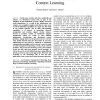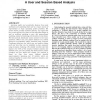173 search results - page 5 / 35 » Towards Artificial Systems: What Can We Learn from Human Per... |
HUMO
2000
Springer
13 years 11 months ago
2000
Springer
Seeing biological motion is very important for both humans and computers. Psychophysics experiments show that the ability of our visual system for biological motion detection and ...
CORR
2004
Springer
13 years 7 months ago
2004
Springer
Social insect societies and more specifically ant colonies, are distributed systems that, in spite of the simplicity of their individuals, present a highly structured social organi...
ICS
2005
Tsinghua U.
14 years 1 months ago
2005
Tsinghua U.
Learning useful and predictable features from past workloads and exploiting them well is a major source of improvement in many operating system problems. We review known parallel ...
AICOM
2002
13 years 7 months ago
2002
The computational potential of artificial living systems can be studied without knowing the algorithms that govern their behavior. Modeling single organisms by means of socalled c...
AIED
2009
Springer
13 years 5 months ago
2009
Springer
Educational games may be particularly suited to teaching social learning skills with virtual humans. We investigate the importance of social goals and engaging social interactions ...


